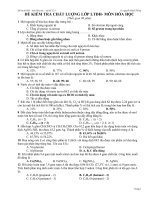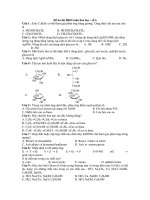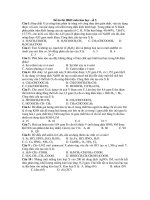Đề ôn thi thử môn hóa (613)
Bạn đang xem bản rút gọn của tài liệu. Xem và tải ngay bản đầy đủ của tài liệu tại đây (149.91 KB, 5 trang )
CHAPTER 36 Critical Care After Surgery for Congenital Cardiac Disease
403
have two good-sized ventricles (unless accompanied by other lesions, such as an unbalanced AV septal defect). This disease can
exist in a spectrum with confluent central pulmonary arteries and
a short-segment main pulmonary artery atresia to discontinuous
pulmonary arteries without a true central pulmonary artery.
In the former situation, the pulmonary artery arborization is
often close to normal, with few MAPCAs. When antegrade flow
is established from the RV into the main pulmonary artery by a
reparative procedure, the left-to-right shunt via collateral flow will
impose a diastolic load on the LV. Preoperative occlusion of these
collateral vessels can be accomplished by interventional techniques in the cardiac catheterization laboratory but may leave the
child precariously cyanotic in the hours before operation. The alternative is to complete the surgical procedure in a hybrid suite.
This spectrum of the lesion is completely repaired in the neonatal
period.
As mentioned, MAPCAs may be present to varying degrees,
supplying some or all segments of the lung. They can be associated with a large left-to-right shunt, contributing to volume
overload and pulmonary hypertension. Larger collateral vessels
supplying significant portions of the lung can be anastomosed or
“unifocalized” to the native pulmonary arteries, with the ultimate
aim being to establish full antegrade pulmonary blood flow.
Smaller vessels to some segments of the lung can be coiled in the
cardiac catheterization laboratory provided that there is antegrade
flow from the native pulmonary arteries to those lung segments
(dual supply).
When the pulmonary arteries are diminutive, it is important
to establish early antegrade flow from the RV to the pulmonary
artery in an effort to promote growth and establish a pathway to
the pulmonary arteries for subsequent balloon dilation. A modified BT or Mee shunt may initially be necessary to provide sufficient pulmonary blood flow if the pulmonary arteries are exceedingly small. Initially, the VSD can be left open; postoperative
management of cyanosis or CHF will be determined by the size
of and resistance offered by the pulmonary circulation. The course
in these patients can be dynamic and demanding for even the
most experienced practitioners. When collaterals are unifocalized
in the operating room and RV to diminutive pulmonary artery
continuity is established, cyanosis may ensue, and therapy is
aimed at lowering PVR or (re)establishing adequate pulmonary
blood flow. On the other hand, if the child is fully saturated in the
aorta with elevated pulmonary artery oxygen saturation and LA
pressure, then a left-to-right shunt through the VSD may be developing, which will produce a volume load on the LV and an
unstable postoperative course, dictating VSD closure. When the
patient is not fully saturated in the aorta but is suffering from a
volume-loaded LV with low cardiac output and high LA pressure
postoperatively, excessive systemic-to-pulmonary collaterals may
be the culprits, requiring catheterization laboratory investigation
and occlusion or immediate reoperation.
noncompliant postoperatively. This may manifest as requirements
for high filling pressures and consequent right-to-left shunting
through a purposefully patent foramen ovale. With growth and
improved compliance of the RV, the right-to-left shunting diminishes and the infant’s oxygenation improves substantially. If hypoxemia persists, a PGE1 infusion can be reinitiated to temporize
either until accommodation of the restrictive RV physiology or
for a BT shunt.
In patients with long-segment pulmonary atresia, the need for
a conduit to bridge the gap between the RV and pulmonary artery
complicates the repair. Again, RV failure may occur postoperatively, especially when there is a residual VSD or RV outflow obstruction. The conduit may obstruct acutely during chest closure,
further elevating pressure in the RV. The relationship of the conduit to either normal or variant coronary anatomy is vital, as impingement of these structures can present as sudden inexplicable
deterioration at the time of sternal closure.
After the VSD is closed and blood flow from the RV to the
pulmonary arteries is enhanced, there may be excessive pulmonary blood flow (Qp/Qs .1) as a result of the combined flow into
the pulmonary arteries from the RV and from aortopulmonary
collaterals. If this occurs, the patient develops CHF and requires
intraoperative inotropic support and an extended period of postoperative mechanical ventilation. With large collateral flow, the
pulse pressure is wide and diastolic pressure low. The patient may
require surgery to ligate the collateral vessels or may require
embolization.
Critical Care Management
Critical care management of patients with pulmonary atresia is
similar to that for TOF. Maintaining the patency of the ductus for
the perioperative treatment of neonates with pulmonary atresia
and critical pulmonary stenosis is essential prior to additional interventions to establish more permanent pulmonary blood flow.
Following pulmonary valvotomy (interventional or surgical), the
goal of therapy is to improve oxygenation and decrease RV afterload. Because the LV may be more pressure and volume loaded in
this lesion than in the normal fetus, the RV may be relatively
Pathophysiology
In this condition, an imperforate TV and hypoplasia of the RV
are present, often accompanied by a VSD of variable size and by
pulmonic stenosis. The most common form of tricuspid atresia
has normally related great arteries; when associated with transposition of the great vessels, the clinical presentation is similar to
that of hypoplastic left heart syndrome.
In the usual type of tricuspid atresia, an obligatory atrial-level
shunt exists from the RA through the patent foramen ovale or
ASD into the LA, where complete mixing takes place. The degree
Critical Care Management for Late Postoperative Care
Patients with TOF and pulmonary atresia are subject to the same
late problems and complications as patients with TOF alone. In
addition, they will require conduit revisions over their lifetime.
Some patients have accelerated conduit obstruction after surgery,
which is often related to the presence of a porcine valve.204 Consequently, many experts now prefer bovine-valved conduits or
homografts except in certain situations, such as when the distal
pulmonary vascular impedance is high, resulting in central pulmonary artery hypertension. In these situations, a valveless conduit
that permits pulmonary insufficiency (and thus relieves central
pulmonary artery hypertension) is preferred. In cases when pulmonary regurgitant volume load to the RV is undesirable, some favor
the placement of a heterologous bovine jugular vein bioprosthesis
with a trileaflet venous valve.205 This has been the valved conduit of
choice in patients younger than 18 years whenever pulmonary regurgitant volume load to the RV is undesirable.205 Small-caliber
bovine jugular vein conduits may result in significantly improved
freedom from dysfunction at 5 and 10 years’ follow-up compared
with pulmonary homografts in patients who received the operation
during the first 2 years of life.206
Tricuspid Atresia
404
S E C T I O N I V Pediatric Critical Care: Cardiovascular
of hypoxemia depends on the amount of pulmonary blood flow,
which is regulated by the severity of the pulmonic stenosis. This,
in turn, is regulated by the size of the VSD; patients with an
extremely small/restrictive VSD will have pulmonary atresia in
addition to tricuspid atresia. The common presentation is characterized by significant hypoxemia caused by decreased pulmonary
blood flow.
Critical Care Management
The ultimate palliative surgical course for tricuspid atresia is a
modified Fontan procedure. Neonatal hypoxemia prior to surgery
can be effectively stabilized with a PGE1 infusion. An initial palliative procedure may be required to improve pulmonary blood
flow (modified BT shunt) if the child becomes severely hypoxemic. In contrast, if there is excessive pulmonary blood flow, a
pulmonary artery band may be needed. The critical care management and complications are those discussed in the sections on
shunts, banding, and modified Fontan procedures. Complications of chronic hypoxemia and cyanosis are also present.
Left-Sided Obstructive Lesions
Pathophysiology
This category includes valvar, subvalvar, and supravalvar mitral
and aortic stenosis, aortic coarctation, IAA, and HLHS. Although
these lesions can occur as isolated defects, they often coexist
(Shone syndrome) or are accompanied by other congenital cardiac
defects. Identification of additional structural defects is necessary
for optimal preoperative, surgical, and postoperative treatment.
Patients with LV outflow tract obstruction tend to present
either as neonates or as young infants with significant LV dysfunction and CHF or later in childhood with subclinical LV
hypertrophy. The dramatic presentation of a neonate with circulatory collapse typically occurs with lesions that obstruct systemic blood flow so severely that right-to-left shunting at the
ductus arteriosus is required to perfuse the body. As the ductus
significantly narrows or closes, the LV proves inadequate to support the systemic circulation or fails, leading to pulmonary
edema and respiratory distress. When systemic perfusion becomes inadequate, the patient may quickly develop cardiogenic
shock. Classic examples of this physiology include severe (or
“critical”) valvar AS, coarctation of the aorta, and HLHS (see the
earlier single-ventricle discussion).
If the obstruction is less severe, the child can make the transition through ductal closure without notable LV dysfunction and
maintain an adequate cardiac output. Over time, however, the
pressure overload on the LV stimulates generalized hypertrophy. If
untreated and significant, long-term pressure overload can cause
LV diastolic dysfunction (compliance falls and end-diastolic pressure rises, causing pulmonary edema), LV systolic dysfunction,
and episodic myocardial ischemia. Clinical manifestations of
these changes can include reduced exercise tolerance, exertional
chest pain, ventricular dysrhythmias, syncope, and sudden death.
In this situation, significant LV dilation or clinical signs of CHF
are ominous findings associated with a poor prognosis and an
increased surgical mortality rate.
Aortic Stenosis
Of the three anatomic subtypes of AS, valvar AS occurs more
frequently than subvalvar or supravalvar AS. The newborn with
critical valvar AS who develops hypotension and acidosis as
the ductus arteriosus closes requires resuscitation with PGE1 to
restore aortic flow plus mechanical ventilation and inotropic support to achieve stabilization before an intervention is performed.
Currently, balloon dilation of the stenotic aortic valve during
cardiac catheterization is the preferred intervention at most centers. A surgical valvotomy under direct vision using CPB is the
surgical alternative. Despite successful relief of obstruction, significant LV dysfunction and low cardiac output often persist for
days after the procedure and require continued treatment with
mechanical ventilation and vasoactive drugs. Until LV function
recovers and can support the entire cardiac output, a PGE1 infusion may be necessary to maintain a PDA. Patients should be
carefully evaluated after balloon aortic valvuloplasty for residual
AS and aortic insufficiency, the chief potential complication of
valve dilation, especially if cardiac output does not improve over
several days.
Older infants, children, and adolescents with moderate (pressure gradient 50–70 mm Hg at catheterization) or severe (pressure
gradient .70 mm Hg at catheterization) valvar AS also are generally good candidates for balloon aortic valvuloplasty. Usually, if
more than mild aortic regurgitation coexists with AS, surgical
intervention is preferred to balloon valvuloplasty. The pathophysiology produced by all types of aortic outflow obstruction is
similar—that is, the pressure-overloaded LV becomes progressively hypertrophied and develops reduced compliance and an
abnormally elevated end-diastolic pressure.
Initial assessment of obstruction relief can occur when the
patient is still in the catheterization laboratory or operating room
by either direct pressure measurements or echocardiography. Nevertheless, reevaluation for residual obstruction by physical examination or echocardiography in the ICU as patients recover from
anesthesia and baseline physiology returns is important because
outflow gradients can change. A significant residual obstruction
should be suspected in any patient with persistent low cardiac
output following the intervention.
Poor recovery of LV function after surgery can occur secondary
to inadequate myocardial protection with cardioplegia in hearts
with significant ventricular hypertrophy. Patients with marked
hypertrophy are also at greater risk for developing VT and ventricular fibrillation early after surgery.
In patients with preserved LV systolic function who undergo
an uncomplicated procedure, such as aortic valvuloplasty or subvalvar membrane resection, myocardial recovery after CPB is
typically rapid, and inotropic support is usually not required.
Systemic hypertension is more common following relief of LV
outflow obstruction, especially during emergence from anesthesia
and sedation.
Antihypertensive therapy in the initial 24 to 48 hours may be
necessary to prevent an aortic suture line and reconstructed valve
leaflet disruption from excessive stress and to allow adequate hemostasis. Initially, both titratable b-blockers (e.g., labetalol and
esmolol) and vasodilators (e.g., nitroprusside), alone or in combination, are effective in lowering the blood pressure for these patients. However, when using vasodilators, caution must be taken
to maintain adequate coronary perfusion for the hypertrophied
ventricle.
In addition to assessing aortic valve and LV function, an evaluation for complications specific to each procedure is required. For
example, if a myectomy is performed as part of the resection of
fibromuscular subvalvar AS, the possibility of a new VSD, mitral
valve injury, and left bundle branch block should all be assessed.
Following the Ross procedure, it is important to assess patients for
RV outflow tract and LV outflow tract obstruction, because the
CHAPTER 36 Critical Care After Surgery for Congenital Cardiac Disease
RV outflow tract is also reconstructed with a valved conduit. This
procedure involves reimplantation of the native coronary arteries
into the new pulmonary autograft placed in the aortic position;
signs of coronary ischemia, unexplained hemodynamic collapse,
or ventricular arrhythmia should prompt aggressive reevaluation
of coronary flow adequacy.
Coarctation of the Aorta
Coarctation of the aorta is a narrowing in the descending aorta
located at the level of insertion of the ductus arteriosus (juxtaductal or contraductal coarctation). Narrowing of the aortic lumen is asymmetric, with the majority of the obstruction occurring because of posterior tissue infolding, leading to the common
description of a posterior aortic shelf. Depending on the severity
and rapidity of development of the narrowing, patients can present
as neonates with severe obstruction (a critical coarctation of the
aorta) upon ductal closure, as infants with CHF, or as children/
adolescents with asymptomatic upper extremity hypertension
(especially with exercise).
Neonates presenting with critical coarctation of the aorta can
often be distinguished clinically from patients with critical AS by
their clearly discrepant upper versus lower body pulses, perfusion,
and blood pressures. Other features at presentation are similar, including evidence of CHF and inadequate blood flow to tissues.
Because ductal narrowing or closure is common after hospital discharge, these patients often become critically ill and suffer endorgan damage before the ductus arteriosus can be reopened and
resuscitation complete. Intestinal and renal ischemia leading to
necrotizing enterocolitis and renal failure, respectively, are wellknown complications of critical coarctation of the aorta. Echocardiography often reveals additional left-sided defects, such as
bicuspid aortic valve, valvar AS, aortic arch hypoplasia, and VSD.
Preoperative stabilization and management in this clinical scenario
include initiation of PGE1, mechanical ventilation, and inotropic
agents as needed. In addition, these patients require adequate time
for end-organ recovery before performing an intervention. In rare
situations, when the PGE1 infusion is unable to open the ductal
and periductal arch tissue to diminish the afterload on the ventricle
and facilitate cardiac and end-organ recovery, the patient should be
taken to the operating room urgently for coarctation repair.
Coarctation of the aorta also occurs in association with complex
defects, such as D-transposition of the great arteries, single ventricle,
and complete AV canal defect. If the ductus arteriosus is patent during echocardiographic evaluation of a neonate with suspected CHD,
it often is not possible to predict the severity of coarctation of the
aorta with confidence. A patient can have an abnormally narrowed
aorta just proximal to the site of ductal insertion (i.e., the aortic
isthmus) and a posterior shelf but still not develop a severe coarctation of the aorta following ductal closure. Therefore, evaluation of
the potential severity of coarctation of the aorta in the ICU often
involves discontinuing the PGE1 infusion to allow for the ductus to
close, followed by close clinical and echocardiographic reassessment
for clinical manifestations of coarctation. An intervention to reduce
aortic arch obstruction is indicated in any neonate with clinical or
echocardiographic evidence of reduced ventricular function or impaired cardiac output related to coarctation development. These indications are more important than the systolic blood pressure difference between upper and lower body per se, although differences
greater than 30 mm Hg often are accompanied by diminished ventricular function.
The postoperative management of patients following surgical
repair of coarctation of the aorta can vary depending on the age
405
at intervention. However, the key issues for assessment in all patients are adequate relief of obstruction and preservation of spinal
cord function. Upper and lower body blood pressures and pulses
should be compared serially and the lower extremities monitored
closely for the return of sensation and voluntary movement in the
early postoperative period. Equal pulses and a reproducible systolic blood pressure difference less than 10 to 12 mm Hg between
upper and lower extremities indicate an excellent repair. Neonates
and young infants typically require 1 to 2 days of mechanical
ventilation postoperatively. Older children and adolescents often
can be extubated in the operating room and rarely require inotropic support. In fact, these patients repaired at an older age are
increasingly likely to have significant hypertension,207 which
should be treated aggressively early after surgery to reduce the risk
of aortic suture disruption and bleeding. b-Blockers and vasodilators, along with adequate analgesia and sedation, are effective.
Patients with longstanding coarctation of the aorta frequently
have persistent systemic hypertension despite adequate surgical
repair; continued treatment with angiotensin-converting enzyme
inhibitors is advocated to achieve normal blood pressures. Due to
the challenges in managing this cohort of older patients after coarctation repair and the advent of interventional catheterization
approaches, including the use of covered stents, a surgical repair
strategy is increasingly falling out of favor.
Four uncommon complications are associated with surgical
repair of coarctation of the aorta. Postcoarctectomy syndrome
manifests as abdominal pain or distension in older patients and is
presumably caused by mesenteric ischemia from reflex vasoconstriction after restoration of pulsatile aortic flow. Recurrent laryngeal nerve and phrenic nerve trauma can cause vocal cord paralysis and hemidiaphragm paresis or paralysis, respectively, with
neonates and infants at highest risk. Disruption of lymphatic vessels or thoracic duct trauma can produce a chylous effusion that
may require treatment by drainage, dietary modification, or surgical ligation of the ductus.
Catheter-directed balloon angioplasty is used to treat both native and residual coarctation of the aorta.208 The results of native
coarctation of the aorta dilation after early follow-up appear
similar to published surgical results, but aortic aneurysm formation has been reported. Balloon angioplasty of recurrent coarctation of the aorta after surgery is effective and is generally preferred
to reoperation.
Interrupted Aortic Arch
Patients with IAA typically present as neonates with either a loud
systolic murmur or circulatory compromise as the ductus arteriosus closes. Therefore, patient presentation can be similar to other
critical left-sided obstructive lesions. Unlike either critical AS or
coarctation of the aorta, however, severe pressure overload on the
LV does not occur in the presence of an unrestrictive VSD, which
functions as a “pop-off” for LV outflow. The approach to resuscitation is similar to that described for the other ductal-dependent
left-sided obstructive lesions, with attention to the possibility of
pulmonary overcirculation as for HLHS.
Postoperative management issues specific to patients with IAA
include assessment of possible residual left-sided obstruction both
in the aortic arch and in the subaortic region, shunting across a
residual VSD, hypocalcemia (related to the 22q11 syndrome),
dysrhythmias, and LV dysfunction with low cardiac output secondary to global effects of CPB and deep hypothermic circulatory
arrest. Left-lung hyperinflation on postoperative chest radiographs suggests compression of the left main stem bronchus. This
406
S E C T I O N I V Pediatric Critical Care: Cardiovascular
complication tends to occur after difficult arch reconstructions
when tension on the aorta causes it to press on the anterior surface
of the bronchus, thus producing distal air trapping.
Hypoplastic Left Heart Syndrome
Pathophysiology
Among the congenital heart lesions, perhaps the most controversial has been HLHS. Left untreated, HLHS is a uniformly fatal
disease; debate continues regarding the optimal management
strategy (i.e., staged palliation, neonatal transplantation, or comfort care). Currently, the 14-month transplant-free survival ranges
from 65% to 75%, making the transplantation waitlist mortality
unacceptable for these patients. The results of surgical management vary among institutions and are clearly dependent on expertise and experience,209 the clinical condition of the neonate at
presentation,210 degree of prematurity, associated congenital
anomalies, presence of an intact atrial septum, age at presentation,211,212 and degree of hypoplasia of left heart structures.212,213
This common example of single-ventricle physiology also represents the most severe form of obstructive left heart lesion. An anatomic spectrum of disease is implied for the lesion; however, in its
most severe and common presentation, there is atresia or marked
hypoplasia of the aortic and mitral valves with critical underdevelopment of the left atrium, left ventricle, and ascending aorta. A 1or 2-mm diameter ascending aorta gives rise to the coronary circulation and to the head vessels before convergence with the ductus
arteriosus, where the aorta becomes larger and supplies the circulation to the lower body. Pulmonary venous blood returns to the diminutive left atrium and cannot cross the atretic mitral valve. It is
instead directed to the right atrium and RV, where it mixes with
systemic venous return and is ejected into the pulmonary artery.
Systemic blood flows from the pulmonary artery, across the PDA,
to the aorta. As the PDA constricts in the neonatal period, systemic
blood flow decreases and all ventricular output is directed to the
lungs. The Qp/Qs ratio approaches infinity as Qs nears zero. The
patient consequently presents with a high Pao2 (70–200 mm Hg),
shock, and profound metabolic acidosis. When the ductus arteriosus is reopened with PGE1, systemic perfusion is reestablished, the
acidosis resolves, and the Pao2 returns to the range of 40 to 60 mm
Hg, representative of a Qp/Qs ratio between 1 and 2.
Critical Care Management
Preoperative resuscitation with PGE1, correction of metabolic
acidosis, and recovery from end-organ dysfunction are crucial to
the stabilization and management of patients with this lesion.
Resuscitation is enhanced by the judicious use of inotropic agents,
which optimize cardiac output and end-organ perfusion. However, excessive delay in the timing of surgical intervention may
result in a gradual decline in PVR, excessive pulmonary blood
flow, and inadequate systemic perfusion. The surgical reconstructive approach to this lesion now commonly entails three operations intended to provide the child with a reconstructed aortic
arch and Fontan-type single-ventricle physiology by 2 to 5 years
of age.214,215 In the first stage of the reconstruction (Norwood
operation),215 the pulmonary artery is transected at the bifurcation and an anastomosis is performed connecting the pulmonary
trunk to the ascending aorta (above the coronary arteries) to form
a neoaorta, connecting RV, diminutive LV, coronary arteries, and
systemic circulations in an unobstructed fashion. Pulmonary
blood flow is established via a modified BT shunt (usually 3.5
mm in diameter) or a valveless RV-PA (Sano) conduit. The atrial
septum is excised to ensure free flow of pulmonary venous return
to the TV. The Norwood operation may also be performed to
repair other complex single-ventricle defects that include systemic
outflow obstruction or hypoplasia.216
The critical care considerations are the same as those outlined
for patients with single-ventricle physiology. Perioperative management requires optimization of combined ventricular output,
minimization of systemic oxygen consumption, and careful manipulation of Qp/Qs.
Postoperative Management
Evolution of Treatment Strategies. Common teaching has
held that postoperative mortality and hemodynamic instability
result from myocardial dysfunction and the physiologic burden
imposed by shunt-dependent pulmonary blood flow parallel to
the systemic circulation. Treatment strategies have emphasized
factors that affect the balance between pulmonary and systemic
blood flow. Immediately following a Norwood operation, PVR
may be transiently elevated but soon declines. Once PVR falls,
treatment is aimed at raising resistance to blood flow through the
lungs and redirecting cardiac output to the systemic circulation.
High inspired concentration of oxygen, hyperventilation, alkalosis, systemic vasoconstriction, and anemia will cause a further
increase in pulmonary blood flow and should be avoided. Therapies designed to raise PVR and thereby direct aortic blood flow to
the systemic circulation have focused on lowering the Fio2 or on
allowing the Paco2 to rise and the pH to fall toward 7.3. Ventilation with hypoxic gas mixtures or added carbon dioxide has been
advocated by some centers and has been intermittently embraced
and abandoned by others. Validation of the effectiveness of these
techniques to balance the pulmonary and systemic circulations
has been difficult.217,218
The clinical focus of care after Norwood palliation for HLHS
has evolved since the 1990s. The early emphasis was on manipulating the PVR by optimizing mechanical ventilation (i.e., mean
airway pressure, tidal volume, rate and inspiratory time, Fio2, and
Paco2). The objective was to raise PVR and lower pulmonary
blood flow while increasing systemic blood flow. Like any therapeutic strategy, manipulating gas exchange and inspired gases
had its own set of adverse effects. Delivering low Fio2 (below
room air concentrations) leads to alveolar hypoxia and can be
life-threatening. Furthermore, if treatment to elevate PVR is prolonged in preparation for reconstructive or transplantation surgery, PVR may be persistently elevated during and after weaning
from CPB.
In centers where neonates are allowed to awaken and breathe
spontaneously in the immediate postoperative period, pulmonary
blood flow may become excessive. Adding carbon dioxide to the
inspired gas may reverse the tendency toward respiratory alkalosis
and stabilize the relative balance of the pulmonary and systemic
circulations if the forces that drive minute ventilation are suppressed by sedation or analgesia.217,218 However, the metabolic
cost of carbon dioxide breathing in an awakening child may discourage the widespread application of this technique until the
physiologic advantage over conventional means of controlling alveolar ventilation and Paco2 has been demonstrated. This is especially true in unsedated preoperative patients for whom factors
controlling respiration during carbon dioxide breathing may limit
the change of Paco2 yet substantially increase the respiratory rate
and work of breathing.
By the late 1980s it was apparent that (Norwood) palliated
circulation was needed for only 10 to 12 weeks until the
infant reached adequate size for a second stage of palliation
CHAPTER 36 Critical Care After Surgery for Congenital Cardiac Disease
(bidirectional Glenn). The introduction of a 3.5-mm systemicto-pulmonary shunt (rather than a 4-mm shunt) and the appreciation of the surgical complexity of an appropriately placed
shunt did as much to reduce excessive pulmonary blood flow in
infants as did manipulation of the ventilator. Although the
smaller shunts were associated with a rare but real incidence of
shunt thrombosis, those involved in postoperative care found
patient management with a small shunt substantially easier than
struggling with the tendency for pulmonary overcirculation
with a 4-mm shunt. While a relative increase in cyanosis (from
a smaller shunt) was believed to be justified by the greater early
postoperative stability, mortality rates did not plummet with
recognition of the benefits of smaller shunts and PVR manipulation. In the early 1990s it was appreciated that arterial oxygen
saturation was only one variable in the assessment of Qp/Qs. A
perfectly acceptable arterial oxygen saturation of 80% in this
disease may represent severe pulmonary overcirculation if the
mixed venous oxygen saturation is very low (e.g., 20%). Hence,
interest emerged in measuring and monitoring both arterial and
mixed venous oxygen saturations. Thus, in patients with excessive pulmonary blood flow despite a small (3.5-mm) fixed-diameter shunt from the subclavian artery, there was less emphasis on
micromanagement of PVR and enhanced interest in pharmacologic support of cardiac output by reducing systemic afterload
and diminishing the driving pressure across the shunt. Some
have advocated the use of the alpha-blocker phenoxybenzamine
407
to blunt systemic vascular reactivity and dilate the peripheral
circulation,219 but its potent, long-lasting hypotensive effects
and its limited reversibility by alpha-agonists has proven challenging. The phosphodiesterase inhibitors then came to enjoy
widespread use in pediatric critical care. These agents lower
SVR, increase cardiac output, and reduce filling pressures. The
new strategy was to monitor (arteriovenous) Do2, support
cardiac output, and reduce SVR.
Later in the decade, it was observed that some patients had
limited coronary reserve, low mixed venous oxygen saturation,
rising lactate, and collapsed in the first 48 hours after operation.
This emphasized the fundamental limitation of myocardial function and cardiac output of these infants in the early postoperative
period. The morphologic RV and TV seem ill-suited to support
both adequate systemic and optimal pulmonary blood flow after
the Norwood procedure. Several centers then embraced temporary mechanical support of the circulation for the failing Norwood patient in the early postoperative period.
Specific Considerations for the Norwood Operation. Management of patients following a Norwood-type operation is
complex. Intensive monitoring is essential because the patient’s
clinical status can change abruptly with rapid deterioration. Persistent or progressive metabolic acidosis is an ominous prognostic
sign that must be aggressively managed. Considerations in the
assessment of the circulation following the Norwood operation
are given in Table 36.5.
TABLE
Management Considerations for Patients Following a Norwood Procedure
36.5
Scenario
Etiology
Management
Sao2 ,80%
Svo2 ,60%
Normotensive
Balanced flow (Qp 5 Qs)
No intervention
Sao2 .90%
Hypotension
Overcirculated (Qp . Qs)
Low PVR
Large BT shunt
Residual arch obstruction
Raise PVR
• Controlled hypoventilation
• Low Fio2 (0.17–0.19)
• Add CO2 (3%–5%)
• Increase systemic perfusion
• Afterload reduction, vasodilation
• Inotropic support
• Surgical shunt revision
Sao2 ,75%
Hypertension
Undercirculated (Qp , Qs)
High PVR
Small, kinked, thrombosed BT shunt
Lower PVR
• Controlled hyperventilation
• Alkalosis
• Sedation/paralysis
Increase cardiac output
• Inotropic support
Hematocrit .40%
Surgical intervention
Sao2 ,75%
Hypotension
Low Svo2
Low cardiac output
Ventricular failure
Myocardial ischemia
Residual arch obstruction
Atrioventricular valve regurgitation
Minimize stress response
Inotropic support
Surgical revision
Consider mechanical support
Consider transplantation
BT, Blalock-Taussig; Fio2, inspired oxygen concentration; PVR, pulmonary vascular resistance; Qp, pulmonary blood flow; Qs, systemic blood flow; Sao2, arterial oxygen saturation; Svo2, mixed
venous oxygen saturation.









